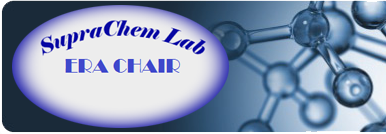|
Group leader:
|
PhD Alexandru Rotaru (ER chemistry)
|
|
Members:
|
PhD Laura Ursu (PD physics); PhD Ioana Moleavin-Turin (PD chemistry);
Lacramioara Lungoci (PhD student biology);
|
|
Subgroup leader:
|
PhD L. Marin (ER chemistry
|
|
Members:
|
PhD Daniela Ailincai (PD chemistry); Andrei Bejan (PhD student MD);
Anda Olaru (PhD student chemistry)
|
This project also focus on the advancement of technologies to prepare breakthrough nanostructured dynamic interactive systems (dynamers, gels, hybrid systems) adaptively and functionally stabilized in onb surfaces or macroporous supports. Within this context, will try to provide deep insights on how the affinities exhibited in nature for carbohydrate-protein, nucleoside-protein, enzyme-substrate interactions are effected in a protective confined environment? Within SUPRACHEM LAB, we hope to gain a critical level of understanding of how synthetic dynamers might be used as scaffolds such as gel components, or as bioconjugates, in biologically and medically relevant research areas. For example Protein-carbohydrate recognition or DNA-transfection or confined enzyme systems of emerging medical importance, relate to the increasing level of refinement of our knowledge about biological codes. A high-density coding system is essential to allow cells to communicate efficiently and swiftly through complex surface interactions. These features motivate the search for mechanisms describing how structure is translated into function mainly with interpreting the biomolecule information content. We hope to gain insight into the spatial behaviour and dispersion of dynameric adaptive structures in confined environments which can be tuned through self-addressable units with structures.The aim will be to obtain an ordered and interconnected porous network in order to maximise the available pore surface and functionality. Such approach in which libraries of functional nanoplatforms decorated with tailored functional groups that exhibit high selectivity for binding with target (bio)analytes and connected by reversible bonds will be confined and used for isoporous membrane functionalization. This will provide new synthetic opportunities as compared to classical method using block-co-polymers, overcoming the time-consuming synthetic steps and the pore obstruction, usually observed. Tailored biofunctional groups (sugars, peptides, etc.) can be included in the structure of such systems, for instance physically entrapped to pave the membrane macropore surface in order to optimize and enhance the affinity with target analytes. Immobilization of dynamers conjugates bearing the biomolecules on their surface will be also carried out to increase the uniform distribution of binding sites within membrane pores. The bioconjugate dynamer sponges involved in the biomolecular recognition can be loaded in the base porous membranes a multivalent presentation very useful for the high selective biocapture of species to be separated. The dynamic character lied to reversible interactions between the continually interchanging components can also make them respond to external stimuli and adjust to form the most efficient confined superstructure, in the presence of the fittest partner, selected from a set of diverse less-selective possible architectures which can form by their self-assembly. From the conceptual point of view these systems will express a synergistic adaptive behaviour: the addition of the fittest stimuli might drive a constitutional evolution of the system toward the selection and amplification of the specific confined superstructure within the membrane in the presence of the stimuli that promoted its generation in the first place. This led to the discovery of the functional supramolecular architecture evolving from a mixture of reversibly insidepore exchanging devices via ionic stimuli so as to improve system properties.
In this project we will try to address the “multivalency” problem in a different way: the interactions will be studied in a biomimetic manner by using multivalent nanoplatforms: nanoparticles, liposomes which stand out as having a powerful potential to accommodate self-assembled biomimetic molecules. Their size and shape range compares favourably with the biological entities with which they can interact and mimic. Within this context, a way to directly address this problem in terms of application is related to 3D surface based systems for biosensing in terms of real-time label-free measurement of biological interactions. The interest in this area stems to a large extent from the versatility, simplicity and inherent sensitivity of the Quartz crystal Microgravimetry - QCM transduction method. The QCM-biosensor simply relies on the change in resonant frequency of the QCM that results from the mass change associated with biological processes on the surface of the quartz crystal.
Supervision/trainer
Prof. Stephane Vincent IAB
Prof. Olof Ramstrom-IAB
Prof. Claudiu Supuran –IAB
Dr. Teodor Aastrup –Trainer
Dr. Narcis Avarvari-Trainer
|



